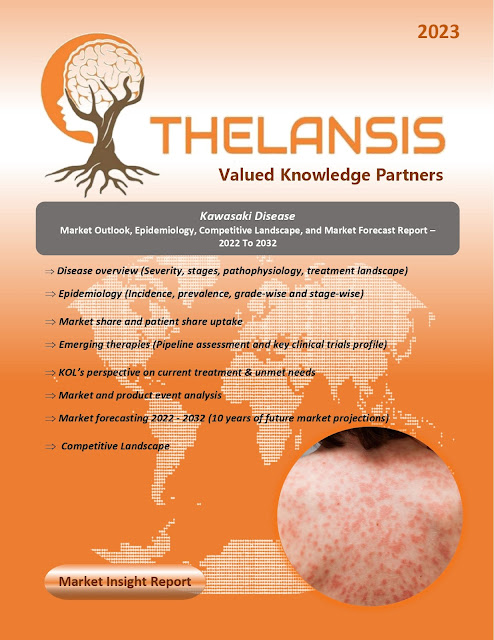Kawasaki Disease (KD) – Market Outlook, Epidemiology, Competitive Landscape, and Market Forecast Report – 2022 To 2032
Kawasaki disease (KD), also referred to as mucocutaneous lymph node syndrome, is an acute medium vessel vasculitis characterized by a preference for the coronary arteries. It is the primary cause of acquired heart disease in developed nations and is progressively surpassing rheumatic heart disease in developing countries. The precise etiology of Kawasaki disease remains unknown, but it may be associated with an airborne or waterborne pathogen. Typically, affected children initially manifest with a high fever that exhibits a remittent pattern and lasts for approximately one to two weeks without treatment. In some instances, the fever may persist for up to three to four weeks. Additional distinctive features include bilateral conjunctivitis (inflammation of the whites of the eyes), inflammation of the mucous membranes of the mouth and throat leading to dry, red, cracked lips and a strawberry-red tongue, cervical lymphadenopathy (swelling of lymph nodes in the neck), redness and swelling of the hands and feet, and a reddish rash that typically affects the trunk and often extends to the groin area. The prognosis of Kawasaki disease depends on the severity of cardiac involvement. Furthermore, the prognosis is more favorable for children diagnosed between the ages of 6 months and 9 years compared to those younger or older, possibly due to earlier diagnosis following the presentation of classic symptoms. Recurrence is infrequent but more likely in younger children who experienced cardiac complications during the initial episode of the disease. All deaths related to Kawasaki disease are primarily attributed to cardiac complications and typically occur within 15-45 days from the onset of fever. The disease can lead to the formation of aneurysms, heart failure, myocardial infarction (MI), myocarditis, valvulitis, pericarditis with pericardial effusion, and rupture of the coronary arteries resulting in hemopericardium and sudden death. Approximately 9% of patients experience acute phase cardiac complications, while about 3% develop cardiac sequelae. Patients with Kawasaki disease frequently experience myocardial infarctions during sleep or rest, suggesting a potential etiology involving coronary vasospasm. Myocardial inflammation is observed in 50 to 70% of patients during the acute phase of the disease, raising concerns about the long-term impact of Kawasaki disease on cardiac function. Kawasaki disease is most commonly observed in children under five and can manifest at any age, including adulthood.
·
In the USA, the estimated incidence of
Kawasaki disease, based on hospital discharge data, is approximately 25 cases
per 100,000 children under the age of five.
Thelansis’s “Kawasaki Disease (KD)
Market Outlook, Epidemiology, Competitive Landscape, and Market Forecast Report
– 2022 To 2032" covers disease overview, epidemiology, drug utilization,
prescription share analysis, competitive landscape, clinical practice,
regulatory landscape, patient share, market uptake, market forecast, and key
market insights under the potential Kawasaki Disease (KD) treatment modalities
options for eight major markets (USA, Germany, France, Italy, Spain, UK, Japan,
and China).
KOLs insights
of Kawasaki Disease (KD) across 8 MM market from the centre of Excellence/
Public/ Private hospitals participated in the study. Insights around current
treatment landscape, epidemiology, clinical characteristics, future treatment
paradigm, and Unmet needs.
Kawasaki Disease (KD) Market Forecast Patient
Based Forecast Model (MS. Excel Based Automated Dashboard), which Data Inputs
with sourcing, Market Event, and Product Event, Country specific Forecast
Model, Market uptake and patient share uptake, Attribute Analysis, Analog
Analysis, Disease burden, and pricing scenario, Summary, and Insights.
Thelansis Competitive Intelligence (CI) practice
has been established based on a deep understanding of the pharma/biotech
business environment to provide an optimized support system to all levels of
the decision-making process. It enables business leaders in forward-thinking
and proactive decision-making. Thelansis supports scientific and commercial
teams in seamless CI support by creating an AI/ ML-based technology-driven
platform that manages the data flow from primary and secondary sources.




Comments
Post a Comment